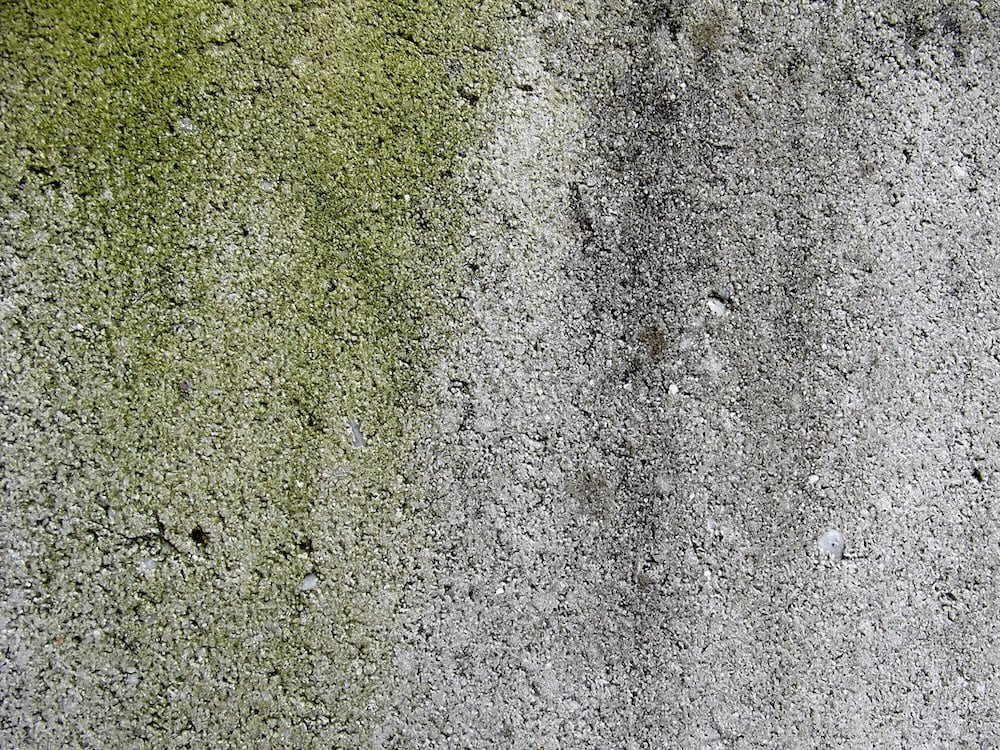Topics:
Search for topics or resources
Enter your search below and hit enter or click the search icon.
Providing your email address will keep you updated should we need to provide updates specific to your location.
April 25th, 2025 | 3 min. read
By Sarah Etler

Mold on your concrete is more than just a cosmetic nuisance – it’s a red flag that moisture is overstaying its welcome. Mold and mildew thrive in cool, moist environments. The shaded corner of your patio? Yep. Your damp basement slab? Check. The sidewalk buried beneath fall leaves? Absolutely.
The good news? You can close out the Amazon tab you’ve got open for a hazmat suit, because in this guide, we’ll walk you through everything you need to know to clean mold from your concrete.
Let’s break down the science. Mold spores are floating through the air pretty much all the time until they land somewhere damp and shaded. Concrete, a porous material, acts like a sponge absorbing moisture within its pores, especially if it’s not properly sealed.
Common mold hot spots include:
Common mold hot spots include:If moisture is seeping into your concrete, and there’s little sunlight or airflow to dry things out, mold will gladly make itself at home…
… and invite its friends.
Okay, you may actually need to reopen that Amazon tab because we need to talk protection. The process of mold cleanup can release spores into the air, and they’re not something you want in your lungs or eyes.

Here are a few essentials you may want on hand before you get down and dirty:
Remove any loose dirt, leaves, or debris with a broom or leaf blower. Mold loves to hide under organic matter, so start with a clean slate and expose where the mold is most concentrated.
Pick the best method for your mold situation:
Safety Tip: Never mix bleach and vinegar. This could create dangerous fumes known as chlorine gas.
After the cleaning solution has soaked in for a while to ensure that all the mold is killed, use your stiff brush or broom to scrub deep into the concrete’s pores. You’ll want to be thorough here – mold clings on tight.
Using a garden hose or a pressure washer, rinse the entire surface. Indoors, use buckets of clean water or a wet/dry vacuum to remove both the cleaner and the loosened mold.
To prevent the mold from returning, you’ll need to seal it. But the concrete must be completely dry before applying a sealer. Give your concrete a chance to dry out in at least 2 to 3 days of dry, sunny weather.
If the area you just cleaned is prone to mold, it’s important to seal the concrete with a high-quality penetrating sealer to prevent it from coming back. Sealing creates a moisture barrier that prevents water from being absorbed into the pores and protects against mold.

Mold prevention is all about keeping the concrete dry and protected. Here’s how to keep your surfaces mold-free:
Related Resource: How to Maintain Concrete
Sometimes mold problems go beyond DIY territory. Here’s when it’s time to contact professionals:
Our team at A-1 Concrete Leveling offers professional cleaning, sealing, and concrete maintenance services to help protect your investment and give you peace of mind.
Mold on concrete isn’t permanent, and it doesn’t have to be a recurring nightmare. With a little know-how and elbow grease (plus the right tools), you can send mold packing. And when you pair your efforts with expert sealing from A-1, you’ll have a mold-resistant surface that stays clean and dry for the long haul.
Need help tackling mold, or just want to clean and protect your concrete the professional way? Request a free estimate from your local A-1 Concrete Leveling team.
Sarah Etler joined A-1 Concrete Leveling after receiving her Bachelor of Arts degree in English from Northern Kentucky University. As A-1's Content Marketing Manager, she works closely with industry experts to produce content that will best answer questions related to concrete repair and maintenance practices. Sarah loves living a life full of discovery and is excited every day to see what new things she can learn and share with those around her.
Topics: